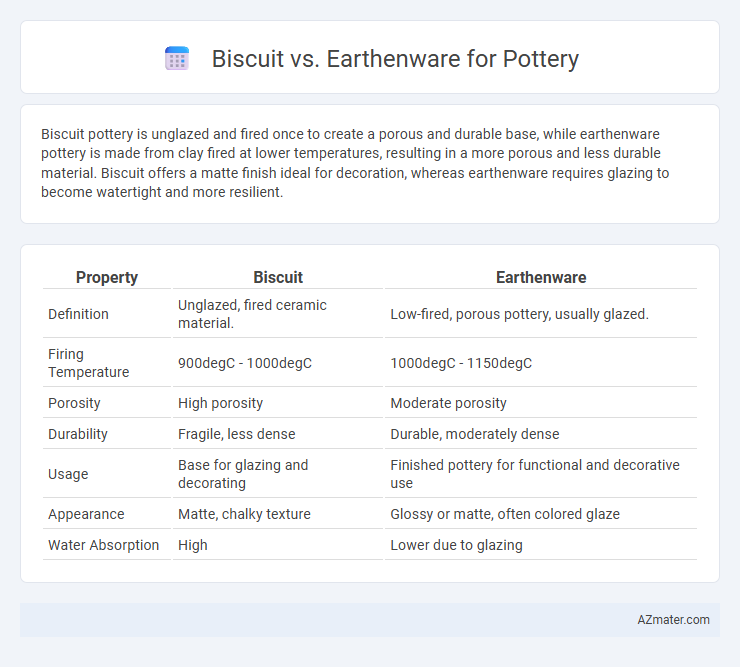Biscuit pottery is unglazed and fired once to create a porous and durable base, while earthenware pottery is made from clay fired at lower temperatures, resulting in a more porous and less durable material. Biscuit offers a matte finish ideal for decoration, whereas earthenware requires glazing to become watertight and more resilient.
Table of Comparison
| Property | Biscuit | Earthenware |
|---|---|---|
| Definition | Unglazed, fired ceramic material. | Low-fired, porous pottery, usually glazed. |
| Firing Temperature | 900degC - 1000degC | 1000degC - 1150degC |
| Porosity | High porosity | Moderate porosity |
| Durability | Fragile, less dense | Durable, moderately dense |
| Usage | Base for glazing and decorating | Finished pottery for functional and decorative use |
| Appearance | Matte, chalky texture | Glossy or matte, often colored glaze |
| Water Absorption | High | Lower due to glazing |
Understanding Biscuit Ware in Pottery
Biscuit ware in pottery refers to clay objects fired once at a low temperature to create a porous, hardened form before glazing. This stage enhances durability and allows for better glaze adhesion compared to unfired clay, distinguishing it from earthenware, which is typically fired at higher temperatures in its finished state. Understanding biscuit ware is crucial for potters aiming to achieve specific textures and finishes in their ceramic creations.
What Is Earthenware? Key Characteristics
Earthenware is a type of pottery fired at lower temperatures, typically between 1000degC and 1150degC, resulting in a porous and relatively soft ceramic body compared to stoneware or porcelain. It is characterized by its reddish-brown or buff color due to iron content in the clay, and it requires glazing to become waterproof. Common in traditional ceramics, earthenware is valued for its affordability, ease of shaping, and rustic aesthetic, often used for decorative and functional items.
Composition: Biscuit vs Earthenware
Biscuit pottery consists of fired but unglazed clay, typically made from refined white or red clay bodies, resulting in a porous and absorbent surface ideal for detailed decoration. Earthenware, composed mainly of natural clay mixed with minerals and fired at lower temperatures (typically between 1000degC and 1150degC), retains porosity and requires glazing to be waterproof and durable. The key compositional difference is that biscuit ware undergoes an initial firing to harden the clay before glazing, while earthenware is often glazed and fired once, reflecting variations in mineral content and firing techniques.
Firing Process Differences
Biscuit firing involves firing unglazed pottery at a lower temperature, typically between 900degC and 1000degC, to harden the clay without vitrifying it, creating a porous and durable base for glazing. Earthenware firing occurs at a lower temperature range, around 1000degC to 1150degC, resulting in a more porous and less vitrified ceramic body that remains softer and more susceptible to water absorption. The primary difference lies in kiln temperature and firing duration, with biscuit firing aimed at preparing pieces for glazing and earthenware firing producing finished, often colorful and porous pottery.
Porosity and Water Absorption
Biscuit pottery exhibits higher porosity and water absorption rates, making it less durable for holding liquids without glazing. Earthenware is inherently porous but typically has a lower water absorption rate after firing, due to its denser clay body. Proper glazing on both biscuit and earthenware significantly reduces porosity and enhances water resistance for functional use.
Surface Texture and Finish
Biscuit pottery, also known as bisque, features a porous, matte surface texture due to its unglazed, fired clay state, which allows better absorption of glazes or paints for further decoration. Earthenware, typically glazed, boasts a smoother, often glossy finish that enhances durability and moisture resistance, making it ideal for functional items like dishes and plant pots. The choice between biscuit and earthenware hinges on the desired tactile quality and final aesthetic--biscuit offers a raw, natural feel while earthenware provides a polished, finished look.
Strength and Durability Comparison
Biscuit pottery, or bisque ware, is fired once at a lower temperature, resulting in a porous and fragile surface, making it less strong and durable compared to earthenware. Earthenware undergoes a higher-temperature firing and often receives a glaze, which enhances its strength, water resistance, and durability for functional use. The porous nature of biscuit pottery makes it prone to chipping and breakage, while earthenware's vitrification process improves resilience, making it better suited for everyday handling and long-term use.
Uses and Applications in Pottery
Biscuit pottery, also known as bisque, refers to unglazed ceramics fired once, providing a porous surface ideal for painting, glazing, and detailed decoration in artistic and functional ware. Earthenware is a porous ceramic fired at lower temperatures, often glazed to enhance durability and water resistance, making it suitable for everyday pottery such as plates, bowls, and decorative items. Both materials serve different functional purposes: biscuit is favored for its porous texture in detailed finishing processes, while earthenware is widely used for practical kitchenware and ornamental pottery due to its strength and versatility.
Glazing Suitability for Biscuit and Earthenware
Biscuit pottery, also known as bisque, is unglazed and porous, making it highly suitable for glazing as it absorbs glaze evenly and produces a smooth, durable finish after firing. Earthenware, fired at lower temperatures and more porous than stoneware or porcelain, also accepts glazes well but requires careful sealing due to its higher porosity to prevent water absorption and enhance durability. Both biscuit and earthenware benefit from glazing to improve aesthetic appeal and functional waterproofing, but biscuit provides a better base for uniform glaze application and stronger adhesion.
Choosing the Right Material: Factors to Consider
When choosing between biscuit and earthenware for pottery, consider factors like durability, finish, and firing temperature. Biscuit, or bisque ware, is unglazed pottery fired at a lower temperature, making it porous and ideal for decorative pieces or as a base for glazing. Earthenware, fired at a higher temperature, offers increased strength and water resistance, suitable for functional pottery such as dishes and planters.

Infographic: Biscuit vs Earthenware for Pottery
 azmater.com
azmater.com